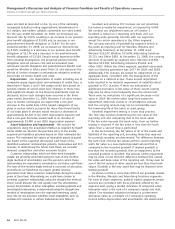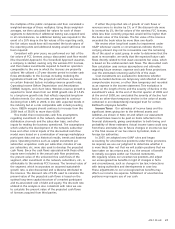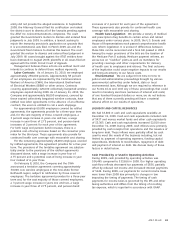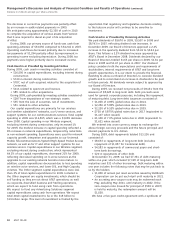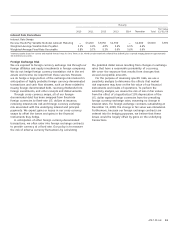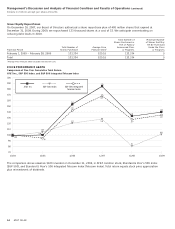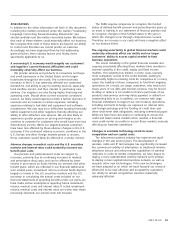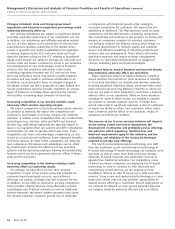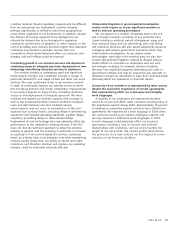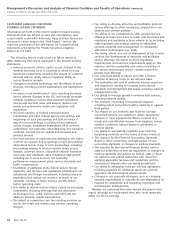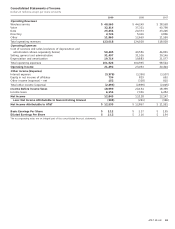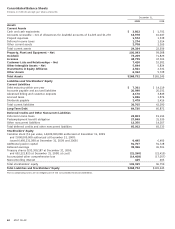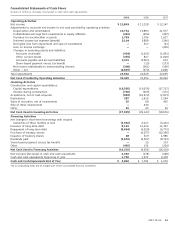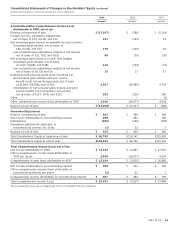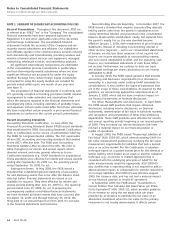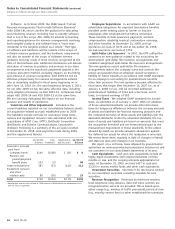AT&T Wireless 2009 Annual Report Download - page 58
Download and view the complete annual report
Please find page 58 of the 2009 AT&T Wireless annual report below. You can navigate through the pages in the report by either clicking on the pages listed below, or by using the keyword search tool below to find specific information within the annual report.
Management’s Discussion and Analysis of Financial Condition and Results of Operations (continued)
Dollars in millions except per share amounts
56 AT&T 09 AR
in comparison with historical growth rates, leading to
increased competition for customers. We expect that the
availability of additional 700 MHz spectrum could increase
competition and the effectiveness of existing competition.
This competition will continue to put pressure on pricing and
margins as companies compete for potential customers.
Our ability to respond will depend, among other things, on
continued improvement in network quality and customer
service and effective marketing of attractive products and
services, and cost management. These efforts will involve
significant expenses and require strategic management
decisions on, and timely implemen tation of, equipment
choices, marketing plans and financial budgets.
Equipment failures, natural disasters and terrorist attacks
may materially adversely affect our operations.
Major equipment failures or natural disasters, including
severe weather, terrorist acts or other breaches of network
or IT security that affect our wireline and wireless networks,
including telephone switching offices, microwave links, third-
party owned local and long-distance networks on which we
rely, our cell sites or other equipment, could have a material
adverse effect on our operations. While we have insurance
coverage for some of these events, our inability to operate
our wireline or wireless systems, even for a limited time
period, may result in significant expenses, a loss of customers
or impair our ability to attract new customers, which could
have a material adverse effect on our business, results of
operations and financial condition.
The success of our U-verse services initiative will depend
on the timing, extent and cost of deployment; the
development of attractive and profitable service offerings;
the extent to which regulatory, franchise fees and
build-out requirements apply to this initiative; and the
availability and reliability of the various technologies
required to provide such offerings.
The trend in telecommunications technology is to shift
from the traditional circuit- and wire-based technology to
IP-based technology. IP-based technology can transport voice
and data, as well as video, from both wired and wireless
networks. IP-based networks also potentially cost less to
operate than traditional networks. Our competitors, many
of which are newer companies, are deploying this IP-based
technology. In order to continue to offer attractive and
competitively priced services, we are deploying a new
broadband network to offer IP-based voice, data and video
services. Using a new and sophisticated technology on a very
large scale entails risks but also presents opportunities to
expand service offerings to customers. Should deployment of
our network be delayed or costs exceed expected amounts,
our margins would be adversely affected and such effects
Changes to federal, state and foreign government
regulations and decisions in regulatory proceedings could
materially adversely affect us.
Our wireline subsidiaries are subject to significant federal
and state regulation while many of our competitors are not.
In addition, our subsidiaries and affiliates operating outside
the U.S. are also subject to the jurisdiction of national and
supranational regulatory authorities in the market where
service is provided. Our wireless subsidiaries are regulated
to varying degrees by the FCC and some state and local
agencies. Adverse rulings by the FCC relating to broadband
issues could impede our ability to manage our networks and
recover costs and lessen incentives to invest in our networks.
The development of new technologies, such as IP-based
services, also has created or potentially could create
conflicting regulation between the FCC and various state
and local authorities, which may involve lengthy litigation
to resolve and may result in outcomes unfavorable to us.
In addition, increased public focus on alleged changes in
the global climate has led to proposals at state, federal and
foreign government levels to increase regulation on various
types of emissions, including those generated by vehicles
and facilities consuming large amounts of electricity.
Increasing competition in our wireline markets could
adversely affect wireline operating margins.
We expect competition in the telecommunications industry
to continue to intensify. We expect this competition will
continue to put pressure on pricing, margins and customer
retention. A number of our competitors that rely on alternative
technologies (e.g., wireless, cable and VoIP) and business
models (e.g., advertising-supported) are typically subject to
less (or no) regulation than our wireline and ATTC subsidiaries
and therefore are able to operate with lower costs. These
competitors also have cost advantages compared to us, due
in part to a nonunionized workforce, lower employee benefits
and fewer retirees (as most of the competitors are relatively
new companies). We believe such advantages can be offset
by continuing to increase the efficiency of our operating
systems and by improving employee training and productivity;
however, there can be no guarantee that our efforts in these
areas will be successful.
Increasing competition in the wireless industry could
adversely affect our operating results.
On average, we have three to four other wireless
competitors in each of our service areas and compete for
customers based principally on price, service/device
offerings, call quality, coverage area and customer service.
In addition, we are likely to experience growing competition
from pro viders offering services using alternative wireless
technologies and IP-based networks as well as traditional
wireline networks. We expect market saturation may cause
the wireless industry’s customer growth rate to moderate


